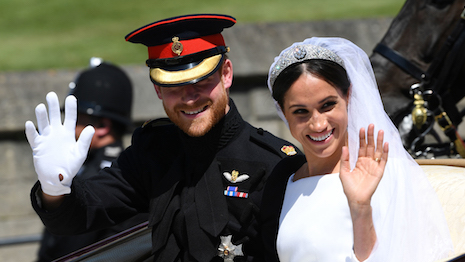 Prince Harry and Meghan Markle's wedding has boosted interest in a number of fashion labels. Image credit: the royal family
Prince Harry and Meghan Markle's wedding has boosted interest in a number of fashion labels. Image credit: the royal family
Following Prince Harry and Meghan Markle’s wedding, the luxury brands that dressed prominent attendees have seen an uptick in consumer attention.
The May 19 ceremony and reception drew out celebrities and famous figures from around the globe, and their attire inspired those who were tuning in at home. From spikes in product searches to social media conversations, the brands present during the nuptials have seen an impact from their connection to the royal affair.
Royal lift
For the ceremony, Ms. Markle worked with Givenchy designer Clare Waight Keller on a custom gown and veil. While the LVMH-owned label is French, Ms. Waight Keller is British, which factored into the bride’s choice.
The three-quarter sleeve dress has an open bateau neckline, while the veil was embroidered with 53 distinct flowers, each representing flora of a particular nation in the Commonwealth.
In addition to a borrowed tiara, Ms. Markle accessorized her bridal look with earrings and a bracelet from Cartier.
The bridesmaids also wore Givenchy dresses, which were paired with white leather Aquazzura shoes. Ms. Markle previously wore the Italian footwear label’s heels for her engagement announcement.
In the 24 hours following the wedding, fashion search platform Lyst noted a 71 percent spike in traffic to Aquazzura.
Prince Harry and his page boys were outfitted by Savile Row tailors Dege & Skinner.
Ms. Markle’s mother Doria Ragland wore a dress and jacket designed by Oscar de la Renta’s Fernando Garcia and Laura Kim.
For the reception, Ms. Markle opted for a Stella McCartney gown. Lyst noted that this brand saw a 3,000 percent growth in traffic following the wedding.
The popularity of Stella McCartney the day after the wedding was also caused by Amal Clooney, who chose to wear a yellow dress from the brand. In the 48 hours following the event, Lyst saw 17,000 people from 65 countries searching for a yellow Stella McCartney dress.
According to data that Influencer DB shared with Women's Wear Daily, both Givenchy and Stella McCartney received significant publicity from their bridal dressing.
Givenchy received $2.9 million in earned media, with 3,000 mentions and more than 12 million likes. Meanwhile, Stella McCartney was mentioned 1,840 times with 9.6 million likes, with a total $2 million in earned media.
Other notable attendees also spiked interest in the brands they wore.
Carey Mulligan wore an embroidered Erdem dress, and the brand saw a 1,000 percent boost in traffic the following day, per Lyst.
Meanwhile, Serena Williams’ Valentino gown worn to the reception grew traffic to the brand’s dresses by 400 percent. Valentino sneakers also saw an 81 percent rise in traffic, courtesy of the athletic-inspired shoes Ms. Williams paired with her outfit.
The Meghan effect
Given the British luxury industry’s considerable ties to the royal family, brands frequently align themselves with major events in the their lives. The monarchy already provides a boost to the United Kingdom economy through brand positioning and tourism, but next year’s nuptial celebrations may provide further benefit to luxury purveyors.
Much like the so-called “Kate Middleton Effect,” in which garments the Duchess of Cambridge wears sell out, Ms. Markle appears to have a similar effect on consumption.
Following the actress’ first appearance with her now husband at the Invictus Games in September, the pair of Finlay & Co. sunglasses she wore attracted attention, crashing the brand’s Web site and leading to sales of about $27,000 in one night (see story).
Now the Duchess of Sussex, the actress turned royalty’s impact on fashion is poised to continue.
During the duchess’ first official appearance after her wedding, she chose a dress by the brand Goat. After being photographed in the almost $800 frock, Goat’s Web site crashed, according to a report in Elle UK.
The last royal wedding of Prince William to Ms. Middleton bolstered high-end brands over the following three years.
A report by Barclays Corporate found that sales in the luxury apparel sector in Britain were expected to increase 29 percent, or $2.6 billion, by 2014 because of the knock-on effect of the wedding (see story).
If the previous nuptials are any indication, the one-day affair will have a lasting impact on the luxury business.
